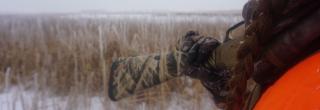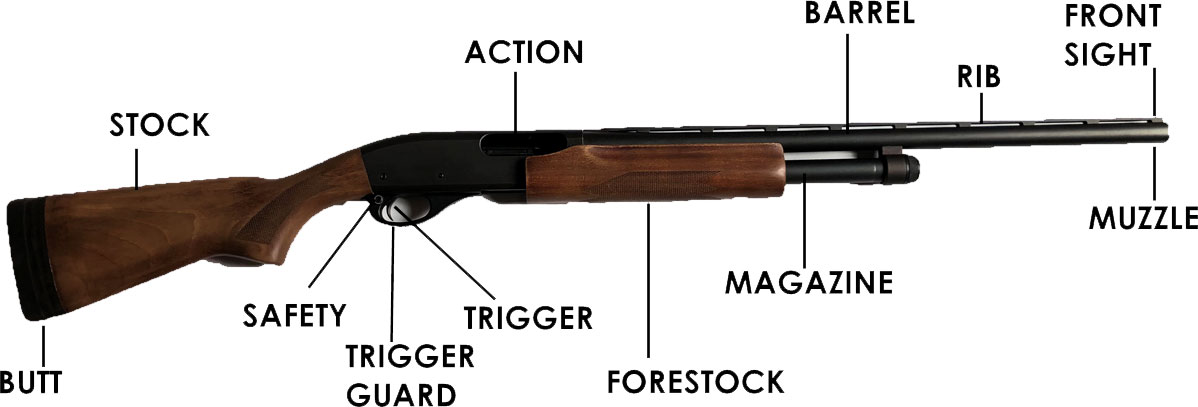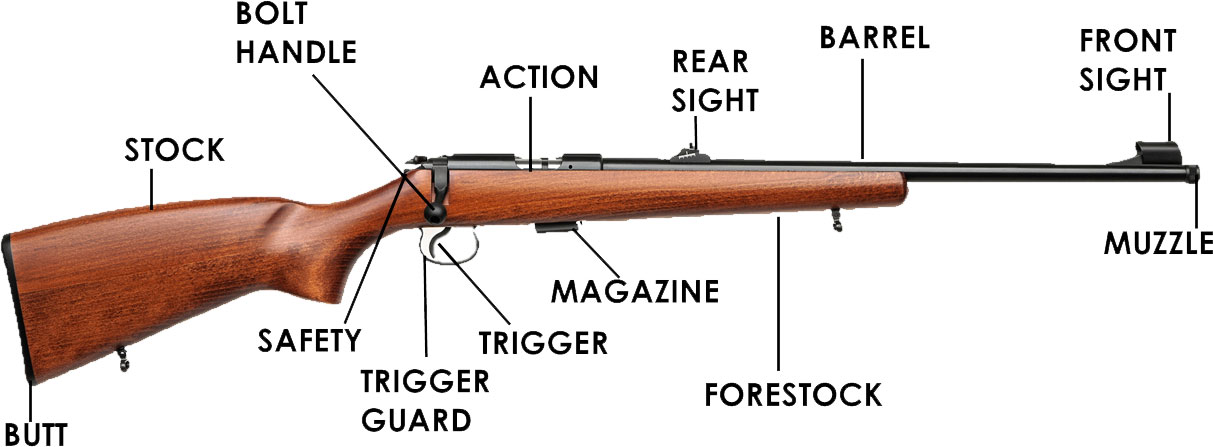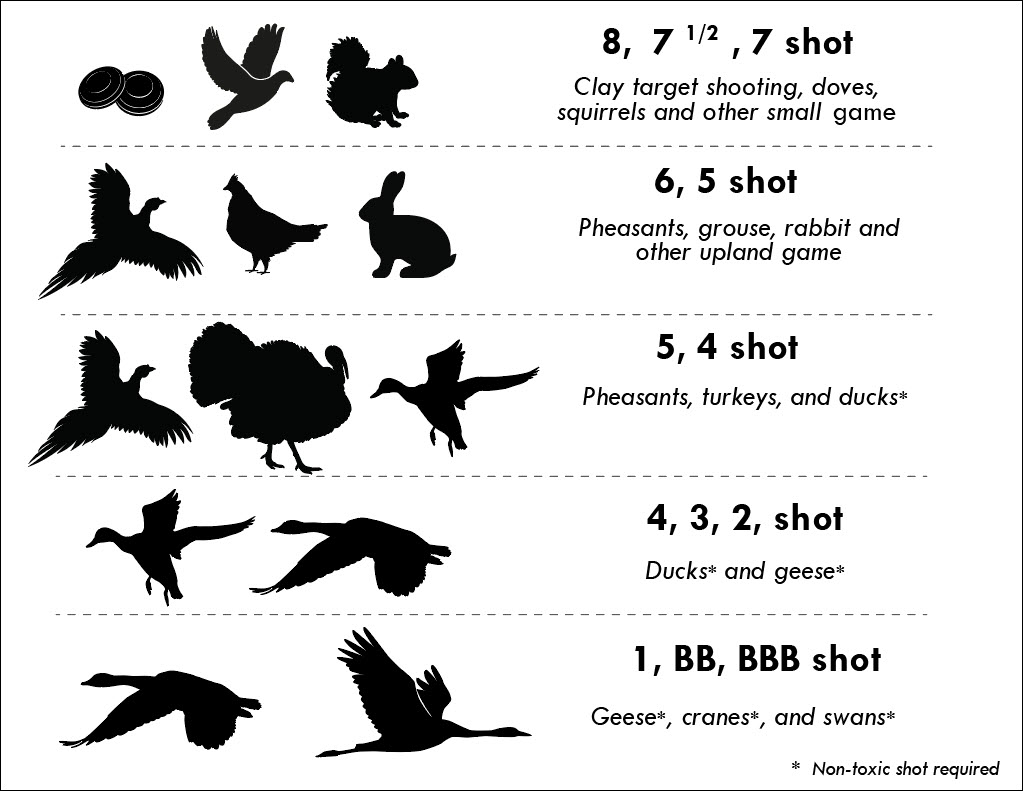
Firearms - General Information
Shotguns
Shotgun: A firearm that shoots shells filled with multiple pellets called shot that form a pattern ideal for hunting small game and moving targets at relatively close distances (e.g. ducks, pheasants, doves, rabbits, and turkey) but can also shoot single projectiles called "slugs" for big game hunting.

Action
The mechanism for loading, unloading and firing the ammunition.
Common Shotgun Actions
- Pump: Manually slide the forestock forward to load a shell, and then slide the forestock backward to eject a shell.
- Uses: Commonly used for turkey, upland or waterfowl hunting.
- Pros/cons: Most affordable, holds 3+ shells and relatively easy to operate but a con is the time required to manually eject and load shells to fire multiple times quickly.
- Break/Hinge: Manually break open the firearm and insert shell(s) right into the barrel and close. To unload, manually break open and pull shells out. Can come with a single barrel, two barrels horizontally orientated called a “side by side” or two barrels stacked called an “over-under”.
- Uses: A traditional gun most commonly used for upland hunting and target shooting.
- Pros/cons: They’re easy to operate and handle in the field but you’re limited to 1 or 2 shells (single or double barrel) and they can be more expensive.
- Semi-automatic: Insert shells into the action and press a button or lever to close. When fired, this gun will automatically eject the empty shell and load a new one for you (essentially automates the process of a pump action) but still only one shell is fired with each pull of the trigger.
- Uses: Most commonly used for waterfowl, upland and turkey hunting.
- Pros/cons: They’re easy to operate and you’re able to shoot 3+ times very quickly, generally “kick” less than a pump-action shotgun, but can be expensive and has mechanical components that can jam or fail (vs break action).
** During almost all hunting seasons, it is illegal to have more than three shells in your shotgun. A plug, (guns often come with it in), is inserted into the magazine to prevent the gun from holding more than three but most can hold more than that without the plug in.
Gauge
The measurement of the diameter of the shotgun barrel. This measurement originally arose from the number of lead balls with that diameter it would take to equal one pound (e.g. it would take 12 lead balls the diameter of a 12 gauge to equal a pound) thus the larger the gauge the smaller the shotgun barrel.
- .410 *the smallest shotgun and does not use the gauge system for its measurement, its diameter is 410/1000ths of an inch and equivalent ~67 gauge
- 28 gauge
- 20 gauge – most common
- 16 gauge
- 12 gauge – most common
- 10 gauge
Ammunition
Shotguns shoot shells that come in a variety of characteristics. When selecting ammunition you need to pay attention to:
- The gauge of your gun (ex: 12-gauge)
- The length of the shells - this influences how many pellets and how much powder fit in the shell. Your gun will say on the barrel what length shells it can hold.
- The appropriate size shot for the game you are hunting; the larger the number, the smaller the size of the pellets.
- Common shot sizes for North Dakota game species:
- 8, 7½, 7 – target shooting, dove hunting, and rabbit hunting
- 6, 5 – upland birds (ex: pheasants), small game and turkeys
- 4, 3, 2 – ducks
- 2, 1 – ducks and geese
- 1, BB, BBB - geese
- Common shot sizes for North Dakota game species:
- Preferences and regulations surrounding the type of metal the shot is made of (ex: it is illegal to use lead shot while hunting waterfowl).
(Note: If you’d like to learn more about non-toxic shot (i.e. steel shot), take a look at Tom Roster’s Nontoxic Shot Lethality Table.)
Chokes
Screws into the inside of the end of your shotgun barrel and determines how tight or spread out the pellets are.
Common shotgun chokes
- Improved cylinder: the least constricted so the shot spreads wide. Used for close range shots common with small game and upland game hunting.
- Modified: the “middle ground,” the shot stays together longer than the improved cylinder so it is more useful at longer ranges, commonly used for upland game and waterfowl.
- Full: The most constricted of the three, holding shot together for very long ranges. Commonly used for turkey hunting.
Rifles
Rifle: A long firearm with spiraled grooving called “rifling” that shoots single projectiles called bullets or cartridges ideal for hunting game at long distances. They come in a lot of different calibers for their many uses (e.g. rabbit hunting to moose hunting) and often people choose to add a magnifying scope.

Action
The mechanism for loading, unloading and firing the ammunition.
Common Rifle Actions
- Lever: Manually swing a handle shut to move a cartridge from the magazine into the chamber and open to eject a cartridge from the chamber.
- Uses: Big game, small game and furbearer hunting.
- Pros/cons: A common gun in the 20th century so often people inherit or purchase used as their first firearm, relatively affordable and easy to operate. Older models often do not come with a “safety” mechanism.
- Bolt: Manually slide bolt forward and shut to move a cartridge from the magazine to the chamber and manually slide back and open to eject a cartridge.
- Uses: Big game, small game and furbearer hunting.
- Pros/cons: They’re common, easy to operate, almost always have a “safety” and are also relatively affordable.
Ammunition
Rifles shoot cartridges/bullets that come in a variety of characteristics. When selecting ammunition you need to pay attention to...
- The caliber of your gun (ex. .243).
- The grain – a measurement of the weight of the bullet. The smaller the grain, the lighter the bullet, the faster it travels and the better it performs at longer ranges. The larger the grain, the heavier the bullet, the more impact it has and the less it’s affected by wind. Like shotgun shells, you will want to weigh the pros and cons of different grains and select a grain that accommodates your needs for the type of hunting/shooting you’re doing.
- Preferences and regulations surrounding the type of metal the shot is made of (ex: some people prefer to use copper bullets because copper is not as toxic as lead if consumed).



